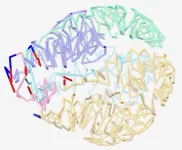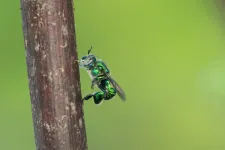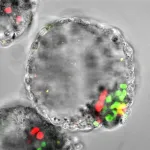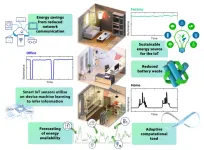(Press-News.org) Choosing a checkout line in a supermarket might seem like a no-brainer, but it can actually involve a complex series of cerebral computations. Maybe you count the number of shoppers in each line and pick the shortest, or estimate the number of items on each conveyor belt. Perhaps you quickly weigh up both shoppers and items and maybe even the apparent speed of the cashier... In fact, there are a multiplicity of strategies for solving this problem.
So how does the brain know how to make decisions in situations like this where there are multiple possible strategies to choose from?
A study published today, April 13th, in the journal Nature Neuroscience provides a surprising answer to this question by showing that, rather than committing to a single strategy, the brain can compute multiple alternative decision strategies simultaneously. The study, led by Fanny Cazettes and senior authors Zachary Mainen and Alfonso Renart, at the Champalimaud Foundation in Lisbon, Portugal, performed a specially-designed experiment which used a kind of “virtual reality” setup for mice, in which the animals were tasked with searching for water in a virtual world.
Specifically, the authors’ designed a "virtual mouse world" containing the kind of foraging problem that animal brains have evolved to be good at, allowing them to study the complex decision strategies used by mice. Any given location in the virtual world could provide water unreliably and, at some point, would “dry up” and cease giving water altogether. The mice had to decide when to leave a given location and move to another in search of more water.
To solve the task optimally, the best strategy would be for the mice to learn to count the number of consecutive missed attempts to get water at a given site, and to switch locations when the number of consecutive misses was sufficiently large. But there were multiple alternative strategies for processing the series of successful and unsuccessful tries, including, for instance, calculating the difference between the number of successful and unsuccessful attempts. Each strategy combines misses and successful tries across time in a particular way, and thus has a signature time course – which is called the “decision variable” – that can be matched against the time course of brain activity patterns.
The researchers recorded activity from large ensembles of individual brain cells in a part of the brain known as the premotor cortex while the mice performed the task. They then looked for combinations of the temporal profiles of activity of recorded premotor neurons which resembled the decision variables associated with the different strategies.
To the authors’ surprise, data showed that, while each mouse focused on their own strategy, their brains did not. Fanny Cazettes explains, “We found that, while activity in the premotor cortex reflected the computation that the mouse was actually using, it also reflected alternative decision variables useful for the same task, and even decision variables useful for other tasks.” Zach Mainen, one of the study’s senior authors, adds that, “Contrary to our experience in checkout lines, we found that the brain can actually perform several different counting strategies at the same time, which is reminiscent of the concept of superposition in quantum mechanics."
Although there is still much to be explored in this area, this study provides an important foundation for future research, "Our findings suggest the need for new ways of thinking about the core processes involved in decision-making and action selection. One of our next steps will be to investigate how the brain selects between different decision variables and how these decisions are translated into action”, says Fanny Cazettes.
What could be the usefulness of representing both used and unused strategies simultaneously? “This arrangement might facilitate cognitive flexibility and learning, because changing strategies only requires attending to the right precomputed decision variable, rather than having to construct it from scratch”, argues Alfonso Renart, the other senior author. “These findings have important implications for our understanding of how the brain processes and selects decision variables in complex environments. There could be implications for the development of more flexible and adaptable machine learning systems, which might be particularly useful in situations where there is a high degree of uncertainty or complexity”, concludes Zach Mainen.
END
RIVERSIDE, Calif. -- 'Tis the season for hiking now that spring has arrived and temperatures are on the upswing. But with hikes come insect bites and on the increase in North America is babesiosis, a malaria-like disease spread especially between May and October by a tick.
Indeed, recent research suggests an increase in the incidence of diseases transmitted by ticks around the world, not just the United States and Canada, due likely to climate change and other environmental factors. Among the tick-borne pathogens, Babesia parasites, which infect and destroy red blood cells, are considered a serious ...
LA JOLLA, CA— Two prominent origin-of-life chemists have published a new hypothesis for how the first sugars—which were necessary for life to evolve—arose on the early Earth.
In a paper that appeared on April 13, 2023, in the journal Chem, the chemists from Scripps Research and the Georgia Institute of Technology propose that key sugars needed for making early life forms could have emerged from reactions involving glyoxylate (C2HO3–), a relatively simple chemical that plausibly existed on the Earth before life evolved.
“We show that our new hypothesis has key advantages over the more traditional view ...
Offshore wind farms in the North Sea reduce the population of loons –fish-eating aquatic birds also known as divers – by 94% within a one-kilometre zone, according to new research published in Scientific Reports. The findings highlight the need to minimise the impact of offshore wind farms on seabirds, while balancing this effort with the demand for renewable energy.
Previous research has found that different seabird species respond to offshore windfarms differently – they may avoid the area which can lead to habitat displacement or they may be attracted to the area which can increase mortality via collisions with the turbines. However, it is difficult ...
Male bees display a remarkable passion for collecting scents: they deposit scents from various sources in special pockets on their hind legs, thus composing their own fragrance. This behaviour has been known since the 1960s. The reason why they do it has been the subject of much speculation just as long. Researchers from Ruhr University Bochum, Germany, in collaboration with colleagues from the University of California at Davis and the University of Florida at Fort Lauderdale, have finally solved the mystery. The bee fragrance serves as a sex attractant and increases the reproductive success of the males, as the team found out after three years ...
A high-throughput single-cell single-mitochondrial genome sequencing technology known as iMiGseq has provided new insights into mutations of mitochondrial DNA (mtDNA) and offers a platform for assessing mtDNA editing strategies and genetic diagnosis of embryos prior to their implantation.
An international team of researchers, led by KAUST stem cell biologist Mo Li, has now quantitatively depicted the genetic maps of mtDNA in single human oocytes (immature eggs) and blastoids (stem cell-based synthetic embryos)[1]. This has revealed molecular features of rare mtDNA mutations that cause maternally inherited diseases.
Mitochondria, the ...
A multi-state study from the Centers for Disease Control and Prevention’s (CDC’s) VISION Network confirms that the Pfizer-BioNTech mRNA COVID-19 vaccine has provided children and adolescents, ages 5-17, with protection against both moderate and severe COVID-19 outcomes.
The study found that for 12-17 year olds, vaccine effectiveness was high against the Delta variant but lower during Omicron dominance, including BA.4 and BA.5. Due to the youngest age (5-11) group’s ineligibility for vaccination during Delta predominance, vaccine effectiveness could be estimated for these children only during the Omicron predominant ...
PLYMOUTH MEETING, PA [April 13, 2023] — The National Comprehensive Cancer Network® (NCCN®) and the NCCN Foundation® today announced four winners for the 2023 NCCN Foundation Young Investigator Awards. These annual awards honor up-and-coming leaders in oncology research working to investigate and advance cancer care. The honorees will each receive up to $150,000 in funding for projects that will run over two years. The selection process is overseen by the NCCN Oncology Research Program (ORP) which will also provide oversight.
“It is a privilege to support these emerging innovators ...
We are often attracted to others with whom we share an interest, but that attraction may be based on an erroneous belief that such shared interests reflect a deeper and more fundamental similarity—we share an essence—according to research published by the American Psychological Association.
“Our attraction to people who share our attributes is aided by the belief that those shared attributes are driven by something deep within us: one’s essence,” said lead author Charles Chu, PhD, an assistant professor at the Boston University Questrom School of Business. “To put it concretely, we like someone who agrees with us on a political issue, shares our music ...
Today the Biophysical Journal is launching a new initiative, the Postdoctoral Reviewer Program. The program provides postdoctoral researchers in biophysics the opportunity to partner with Associate Editors and complete reviews that will be used in deciding whether articles will be accepted for publication.
Candidates for this program must be in a postdoctoral position during the 2023–2024 academic year and a member of BPS in good standing. Applications for the new program will be accepted through July 1 for a single-year term beginning in September 2023. Interested candidates can find more information about the program and application process online.
“I am extremely ...
Newcastle University researchers have created environmentally-friendly, high-efficiency photovoltaic cells that harness ambient light to power internet of Things (IoT) devices.
Led by Dr Marina Freitag, the research group from the from School of Natural and Environmental Sciences (SNES) created dye-sensitized photovoltaic cells based on a copper(II/I) electrolyte, achieving an unprecedented power conversion efficiency of 38% and 1.0V open-circuit voltage at 1,000 lux (fluorescent lamp). The cells are non-toxic and environmentally friendly, setting a new standard for sustainable ...





